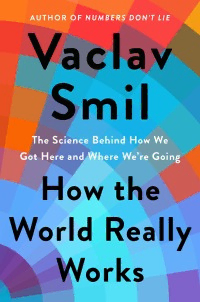
Preview How the World Really Works
Cover Page: i Title Page Page: i Copyright Page: iv Contents Page: v Introduction: Why Do We Need This Book? Page: 1 1. Understanding Energy: Fuels and Electricity Page: 13 Fundamental shifts Page: 13 Modern energy uses Page: 18 What is energy? Page: 22 Crude oil’s rise and relative retreat Page: 28 The many advantages of electricity Page: 31 Before you flip a switch Page: 35 Decarbonization: pace and scale Page: 37 2. Understanding Food Production: Eating Fossil Fuels Page: 44 Three valleys, two centuries apart Page: 48 What goes in Page: 51 The energy costs of bread, chicken, and tomatoes Page: 55 Diesel oil behind seafood Page: 62 Fuel and food Page: 64 Can we go back? Page: 65 Doing with less—and doing without Page: 70 3. Understanding Our Material World: The Four Pillars of Modern Civilization Page: 76 Ammonia: the gas that feeds the world Page: 79 Plastics: diverse, useful, troublesome Page: 84 Steel: ubiquitous and recyclable Page: 88 Concrete: a world created by cement Page: 94 Material outlook: old and new inputs Page: 100 4. Understanding Globalization: Engines, Microchips, and Beyond Page: 103 Globalization’s distant origins Page: 106 Wind-driven globalization Page: 108 Steam engines and telegraph Page: 110 The first diesel engines, flight, and radio Page: 113 Large diesels, turbines, containers, and microchips Page: 115 Enter China, Russia, India Page: 122 Globalization’s multiples Page: 125 The long reach of Moore’s law Page: 127 Inevitability, setbacks, and overreach Page: 129 5. Understanding Risks: From Viruses to Diets to Solar Flares Page: 134 Eating as in Kyoto—or as in Barcelona Page: 137 Risk perceptions and tolerances Page: 141 Quantifying the risks of everyday life Page: 144 Voluntary and involuntary risks Page: 149 Natural hazards: less risky than they look on TV Page: 153 Ending our civilization Page: 157 Some lasting attitudes Page: 163 6. Understanding the Environment: The Only Biosphere We Have Page: 168 Oxygen is in no danger Page: 169 Will we have enough water and food? Page: 172 Why the Earth is not permanently frozen Page: 177 Who discovered global warming? Page: 180 Oxygen, water, and food in a warmer world Page: 183 Uncertainties, promises, and realities Page: 188 Wishful thinking Page: 193 Models, doubts, and realities Page: 198 7. Understanding the Future: Between Apocalypse and Singularity Page: 205 Failed predictions Page: 208 Inertia, scale, and mass Page: 214 Ignorance, persistence, and humility Page: 218 Unprecedented commitments, delayed rewards Page: 224 Appendix: Understanding Numbers Page: 230 References and Notes Page: 235 Acknowledgments Page: 304 Index Page: 305 About the Author Page: 321
Description: